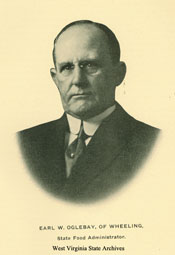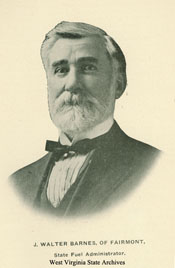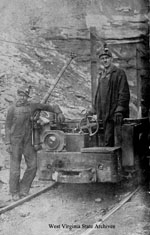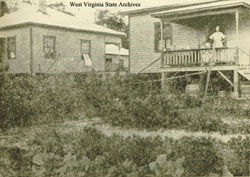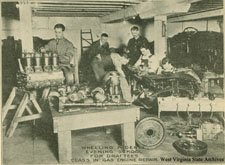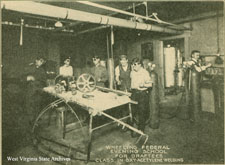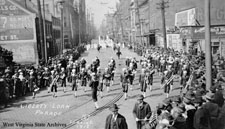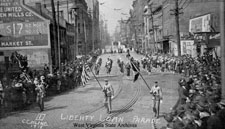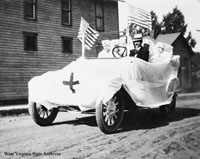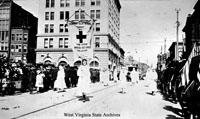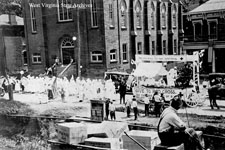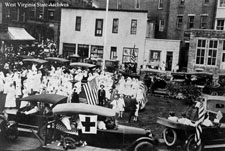

By Tiana Hall | |||||||||||||||||||||||||||||||||||
 William Burdette Mathews, director, Four Minute Men. |
Some men became Four Minute Men, in addition to being army mechanics. The Four Minute Men were speakers who travelled around West Virginia to deliver a four minute "Win-the-War" speech. The speakers were appointed by the State Chairman, who was nominated by the state Council of Defense. Speeches were delivered to urban cities and rural towns. Movie theaters, churches, picnics, fairs, lodges, stores, factories, and street corners were places where the Four Minute Men spoke. Sometimes the speakers' objective was to educate the public, while other times they set out on a money raising campaign. The speakers were not only men. There were also children, known as the Junior Four Minute Men and women, who were raising liberty loans.11 |
Women's Roles on the Homefront
Women were very active supporters of the World War I effort both civically and militarily. Although women were not permitted to join the military, a few participated by being military nurses, while many on the homefront were involved in numerous organizations and even worked in factories. Winning the war would have not been possible if not for the women's help and patriotic dedication to their country.
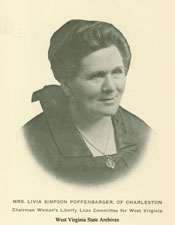 Livia Simpson Poffenbarger, chairwoman, Woman's Liberty Loan Committee. |
Organizations such as the Red Cross and the Liberty Loans were used by women to aid the war effort. The Red Cross is an international humanitarian organization that provides relief to victims of war or natural disaster, which also has local chapters. The local chapter called the Kanawha War Relief was made up almost completely of the Red Cross members, which shipped surgical dressings, hospital supplies, sheets, pillow cases, pillows, shirts, and pajamas to soldiers in France.12 Liberty Loans were war bonds instituted by the U.S. government and sold to support the war effort. War bonds functioned the same way as U.S savings bonds in that one buys a bond and it draws more money or interest over a ten-year period.13 Women in West Virginia tried to get people to subscribe or buy the bonds to raise money to finance military operations. There were a total of four liberty loans which raised $55,646,150 statewide through 500,000 subscriptions, with $18,279,950 of that amount raised by the Woman's Liberty Loan Committee.14 |
 Liberty Bond parade in Fairmont, April 1918. Elizabeth Windsor Collection |
||||
 |
 |
 |
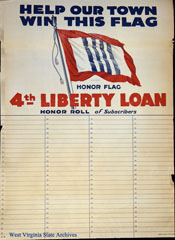 |
|
||||||
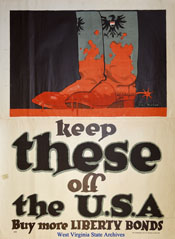 |
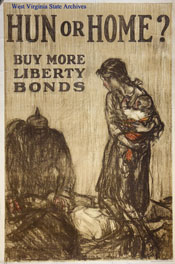 |
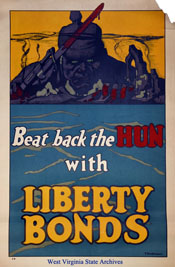 |
 Red Cross women, Marshall College. |
According to the report of the school superintendent, these women and their associates made 25,000 surgical dressings during the 1917-1918 fiscal year. |
| Women also contributed to the war effort through the production and conservation of food. There was a limited amount of food for both civilians and soldiers, so to prevent a food shortage the U.S. government issued ration cards in which only a certain amount of food was allowed per person of each household per day. Canning clubs and victory or war gardens were used amongst women as a private means to reduce the public burden on the food production industry to supply more food.15 |  Victory Garden at West Liberty Normal School, 1918 |
In regards to industry during the war, women's participation was due in part because their husbands were fighting in the war. However, women's entrance into the workforce was unprecedented during this time, as many were socially confined to performing their duties of housewife and mother at home.16 In 1917, 849 factories in West Virginia were inspected and of those factories a total of 8,199 female employees were reported, and that number continued to grow during the war. Women were also employed on the railroads, in post offices, banks, and corporations.17 In Wayne County, the saw mill was run completely by women.18
African Americans Roles on the Homefront
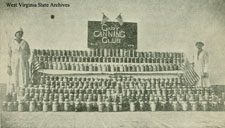 Community Kitchen Canning Club at Gary |
African Americans contributed to the war effort at home, through their participation in the coal industry, canning clubs, the Defense Council, and writing war poems. There were 17,829 African American coal miners in 1918 and they were essential to the flourishing of West Virginia's coal industry, which increased production due to the demands of WWI.19 African American women took part in canning clubs to reduce the public burden on the food production industry to supply more food.20 The Defense Councils, known as the "home defense," were appointed by the governor to perform duties required by the executive body in cities. Under the State Council of Defense was the Auxiliary of Defense Council. Auxiliary Advisory Councils of Defense duties included conserving food, raising money for the war effort, and educating the public on the importance of patriotism to the war effort. White women and African American men and women were members of the auxiliary council.21 For the first time the African Americans had a voice, as members of the auxiliary council petitioned to have the racist silent movie called The Birth of the Nation barred on the grounds that it promoted disunity in a time that the nation should be united.22 |
 Ethel and Ada Peters |
African Americans also demonstrated that they had a voice and influence over the general public with the publishing of the book known as War Poems, which featured a series of 24 poems written by two sisters named Ada and Ethel Peters, who were from Beckley. The sisters' main objective described in the preface was to show the African Americans' "loyalty to the Stars and Stripes, in the war with Germany; and to show the need for unity of all men and to fight for democracy." Their book had patriotic poems as well as poems about the African Americans plight as victims of discrimination in the U.S. Overall the African American people were oppressed and silenced by the white people, especially African American women, therefore, this work of literature being published was a remarkable accomplishment.23 | 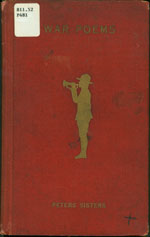 Cover of War Poems |
Children's Roles on the Homefront
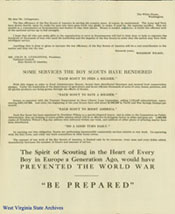 Boy Scout flyer |
Children were encouraged by adults to do a number of things to support the war effort, which included working in factories, joining the Junior Red Cross, and taking part in canning clubs and in the growing of victory gardens. Although Child Labor Laws had just come into effect in 1917, hardly any of the factories followed regulations, so children worked in the factories to support their families financially while their fathers were away at war.24 A total of 50,000 Junior Red Cross members produced garments for refugees and articles for camp supplies. Almost all schools in the state took part in victory gardens and a total of 25,000 high school children joined the agricultural club, pledging to produce food for a soldier.25 Additionally, the Boy Scouts of America, a values-based, character development youth organization, participated in a national and statewide effort to support the war. The Secretary Advisory to the West Virginia Council of Defense, J.V. Sullivan made this statement about what the role of Boy Scouts in World War I, "The Boy Scout's help in the prosecution of the world war cannot be minimized. He is recognized by the State Council as one of the official war agencies which can be utilized in all patriotic activities."26 | 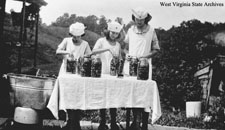 4-H members canning project at Abbott |
Citations
1. Davis, L. M. "The Federal Food Administration for West Virginia," in West Virginia Legislative Hand Book and Manual and Official Register 1918, ed. John T. Harris, (Charleston, WV: The Tribune Printing Co., 1918). Print. 872-877.
2. Barnes, J. Walter. "The Federal Fuel Administration," in West Virginia Legislative Hand Book, 883-887.
3. Sullivan, Jesse V. "The State Council of Defense," in West Virginia Legislative Hand Book, 785-786.
4. Heatherman, W.J. West Virginia Annual Report of the Department of Mines 1918. (Charleston, WV: Tribune Printing Co., 1918). Print. 7.
5. Sullivan, 785-786.
6. Sullivan, 785-786.
7. Stewart, J. H. Third Biennial Report of West Virginia Department of Agriculture 1917-1918. (Charleston, WV: Tribune Printing Co., 1918). Print. 38-39.
8. Marsh, J. F. "The Schools in the War," in West Virginia Legislative Hand Book, 899.
9. Shawkey, M. P. Biennial Report of the State Superintendent of Free Schools of West Virginia 1917-1918. (Charleston, WV: Tribune Printing Co., 1918). Print. 41.
10. Marsh, 899.
11. Mathews, William B. "The Four Minute Men," in West Virginia Legislative Hand Book, 912-914.
12. Poffenbarger, Livia S. "Women in the War," in West Virginia Legislative Hand Book, 901-903.
13. Investopedia, LLC, 2017. Web, http://www.investopedia.com/terms/l/liberty-bond.asp. Accessed 28 May 2017
14. Poffenbarger, 910.
15. Poffenbarger, 905.
16. Poffenbarger, 905.
17. Montgomery, Samuel B. Fourteenth Biennial Report of the Bureau of Labor of West Virginia 1917-1918. (Charleston, WV: The Tribune Printing Co., 1918). Print. 8
18. Poffenbarger, 905.
19. Heatherman, 11.
20. Stewart, 42.
21. Gilmer, John. "The Auxiliary Advisory Council of Defense," in West Virginia Legislative Hand Book, 815-817.
22. Sullivan, 786-787.
23. Peters Sisters, War Poems, (n.p.: n.p., 1919). 811.52 P481 West Virginia Archives and History.
24. Montgomery, 8-9.
25. Marsh, 898.
26. James F. Brown III Collection, MS 2016-071, Box 4, Folder Boy Scouts, West Virginia State Archives.

